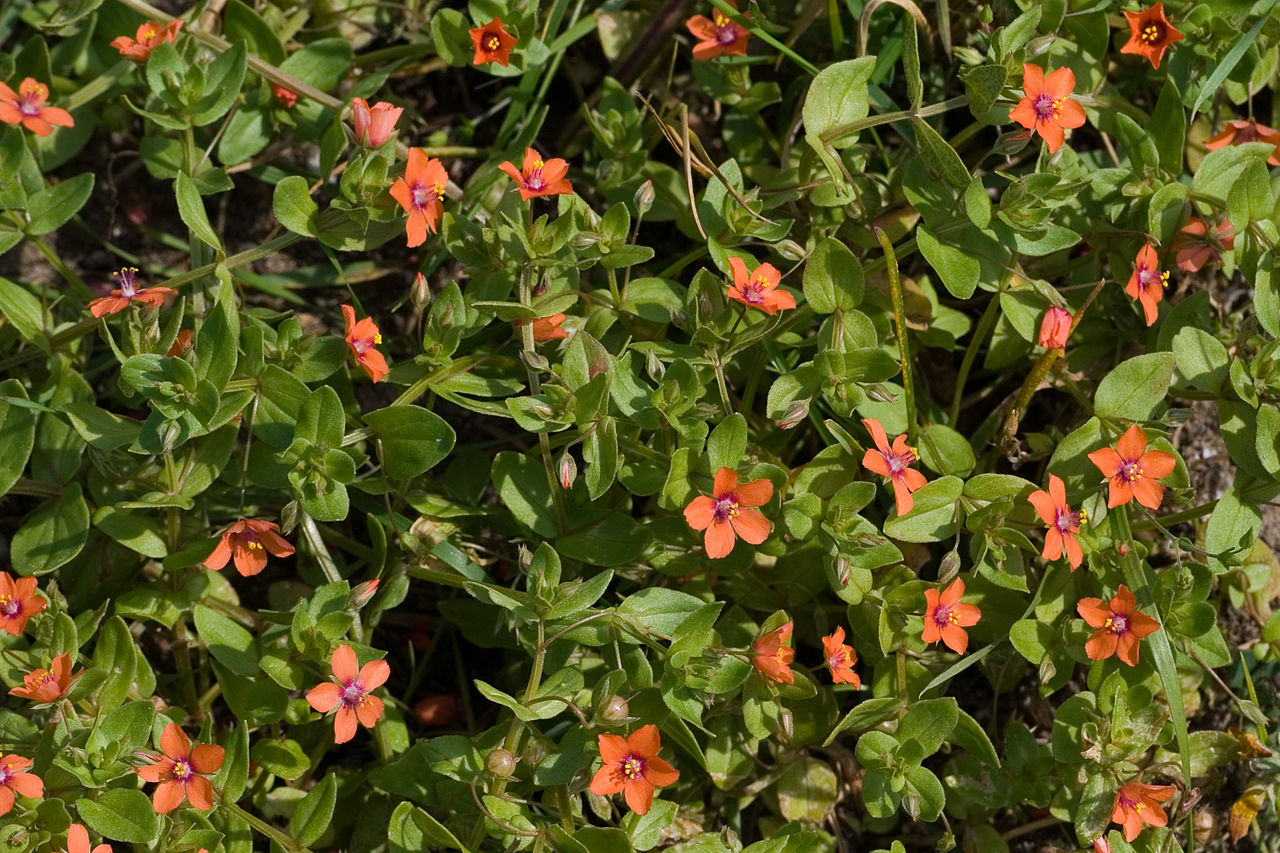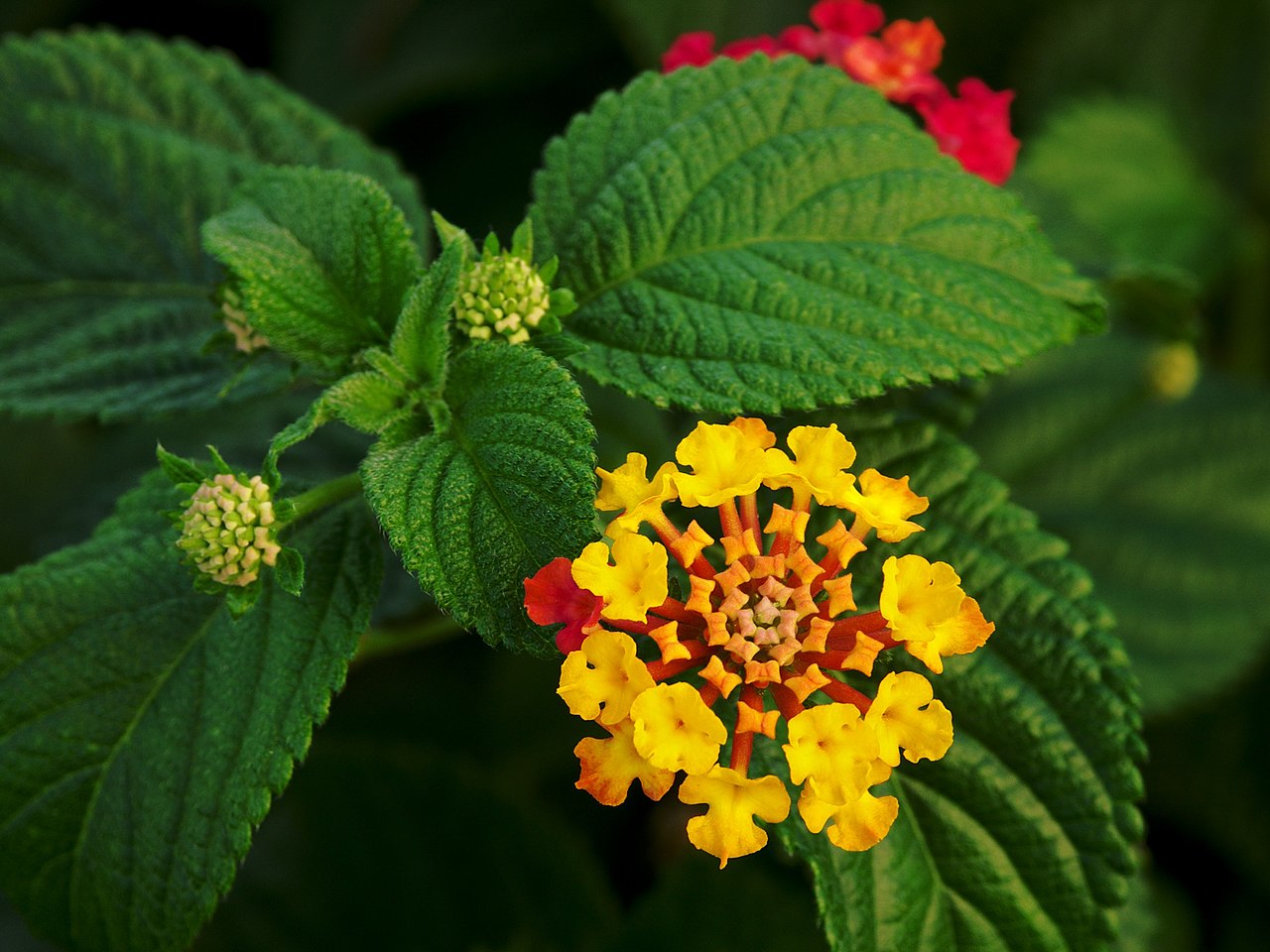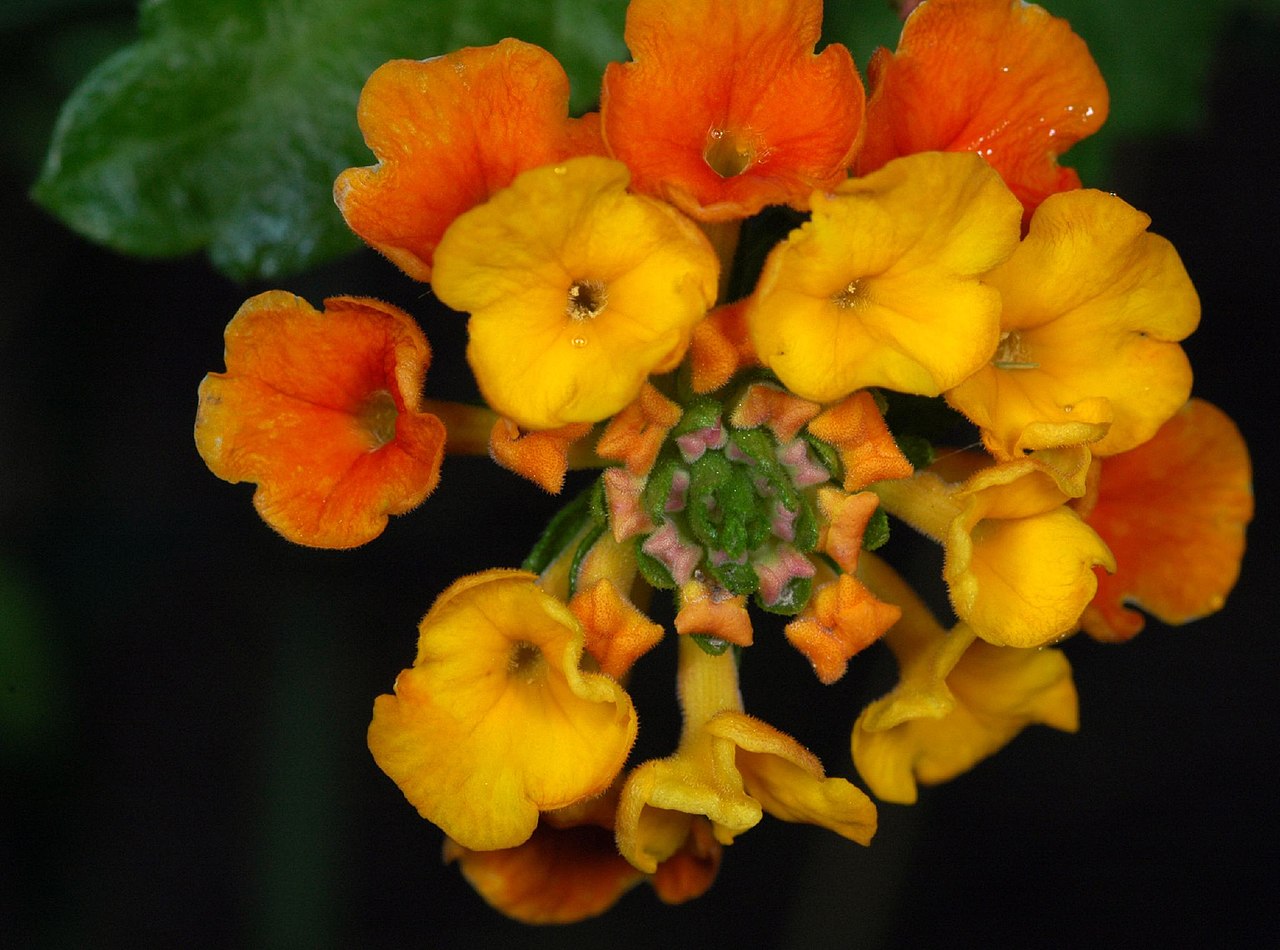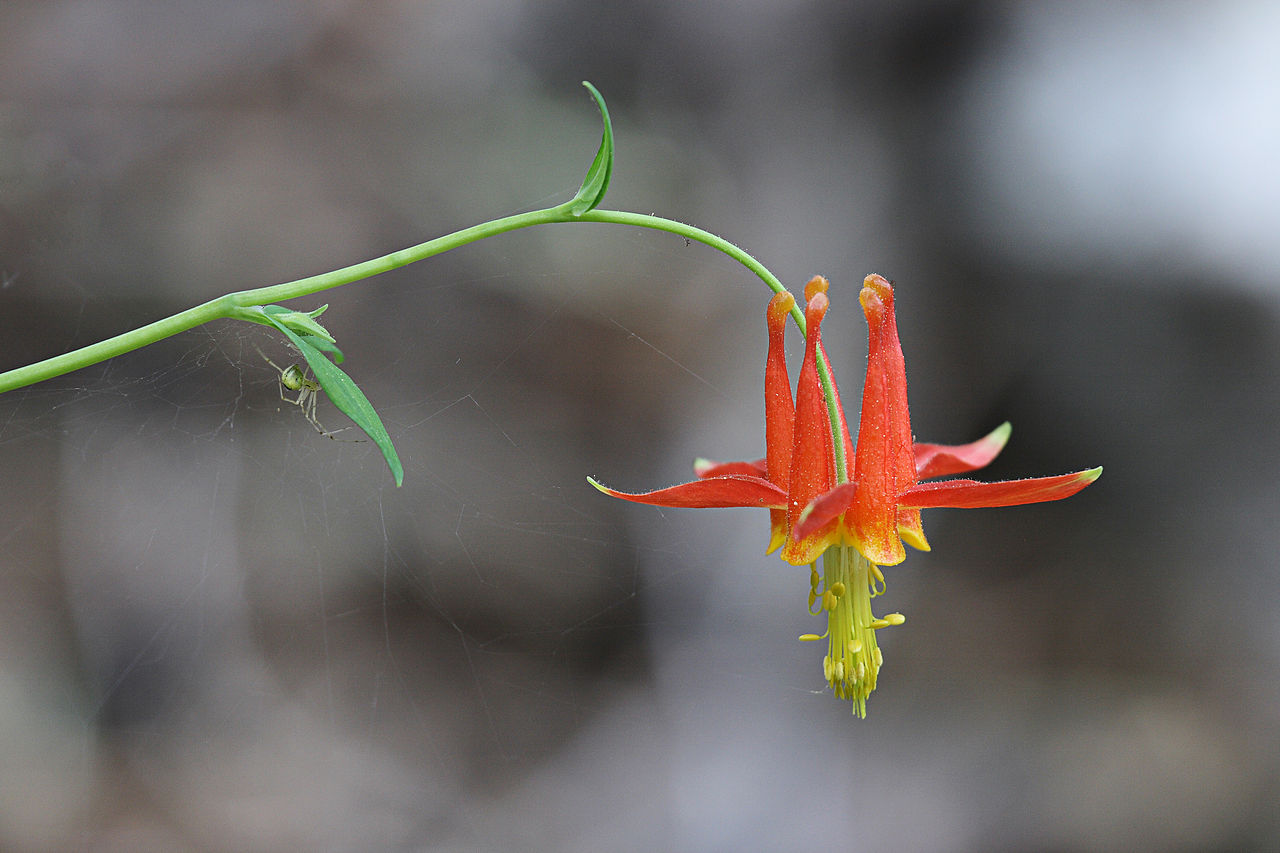When the weather starts to warm and spring arrives, the county is filled with beautiful wildflowers that brighten parks, woodlands, prairies, and more.
Many of these wildflowers are a beautiful orange, creating beautiful scenery wherever you are in the United States. Continue reading below to identify the common orange wildflowers you may come across from spring through to fall.
The common wildflowers you may find in the United States include:
Table of Contents
1. Common Jewelweed
The Common Jewelweed (Impatiens capensis) is also known as the spotted touch-me-not. It is an annual plant, native to North America. You will often find it along creeks and in ditches.
This herbaceous plant grows to 1.5 meters in height and blooms from late spring to early fall.

It produces orange flowers, which are sometimes a deep blood-orange. The plant branches with round, smooth stems and alternating leaves on the upper stems. The leaves are opposite on the lower stems.
This plant originates from England and France and was transported to the United States in the nineteenth and twentieth centuries. It has naturalized populations. It has been classed as a noxious weed in the state of Washington due to its rapid spread and how it out-competes native jewelweeds.
2. California Poppy

The California Poppy (Eschscholzia californica) is native to the United States. It is often cultivated as an ornamental plant that flowers in spring. It has cup-shaped flowers in brilliant orange. The flowers are sometimes red, yellow, pink, and white.
This is a perennial or annual plant that grows to thirty centimeters in height. It has alternating blue-green leaves. The flowers sit alone on a long stem. The four-petaled flowers are beautiful orange and can be seen from February to September. The petals close at night or when the weather is cold and open during the morning.
3. Butterfly Milkweed

Butterfly Milkweed (Asclepias tuberosa) is native to eastern and southwestern North America. It attracts butterflies with its nectar production and beautiful color. This perennial plant grows to one meter in height with spirally arranged leaves.
The upper axils produce umbrels of orange flowers. The flowers have five petals and five sepals. This beautiful orange wildflower is common from South Dakota to Texas and Utah to Arizona. It prefers dry sand and is often found on stream margins where it requires full sun.
4. Scarlet Pimpernel

The brightly colored Scarlet Pimpernel (Lysimachia arvensis) is also known as the poor man’s weather glass and has bright scarlet flowers. It has been widely distributed in Europe and North Africa and used as an ornamental flower. It has naturalized in the United States.
It is often considered a weed and an indicator of light soil. It has a low-growing creeping habit with weak sprawling stems. It has bright green leaves that appear as opposite pairs. The symmetric flowers are brilliant orange, red, or blue. The flowers are single on a leaf axis and can be seen from spring to fall.
The petal margins and stamens have hairs, attracting pollinators. The flowers only open when the sun is shining and will close on colder days and at night. This is why it got the name poor man’s weather-glass. You can find it along roadsides.
5. Orange Bush Monkeyflower

The Orange Bush Monkeyflower (Diplacus aurantiacus) is a flowering wildflower that grows in a shrub form. It is native to southwestern North America and can be found from Oregon to California. The plant can grow to 1.2 meters in height with green, sticky leaves and vertical flowering stems.
The tubular flowers are light orange but can be found in white or red. They are pollinated by hummingbirds and bees. They grow in numerous climates, doing well in soil that is wet, rocky, dry, or sandy. It is an important host plant for the common buckeye butterfly larvae.
This orange wildflower has been used as a medicinal plant by Native Americans for years. The plant is often used to treat burns, eye irritation, and sores. The flowers are used as decoration.
6. Western Wallflower

The Western Wallflower (Erysimum capitatum) is also known as the prairie rocket. It is found throughout North America with a small distribution in California. This mustard-like plant has thin stems that are erect with beautiful and bright flowers.
The flowers are primarily orange but can be found in bright gold and yellow. Some plants have red, purple, or white flowers. The four-petaled flowers can be found in foothills, coniferous forests, and plains.
It is also used for medicinal purposes and the plant is believed to relieve muscle aches. The flower and fruit are eaten for stomach aches.
7. Orange Hawkweed

Orange Hawkweed (Pilosella aurantiaca) is also known as the devil’s paintbrush. This perennial flowering plant is native to the alpine regions in Europe and has been introduced to the United States.
It is a low-growing plant that has a basal rosette of leaves. The plant gives off a milky sap. The leafless flower stem has stiff hairs and can grow to sixty centimeters in height with up to twenty-five flower heads. The flowers are orange, though almost red, reflecting ultraviolet light to increase pollination.
Various insects visit this orange wildflower including butterflies and bees. It is often grown as an ornamental plant in gardens with decorative orange flowers. You are likely to see it in wildflower gardens as the orange flowers encourage pollinators.
It is considered an invasive species in numerous United States states, including Minnesota and Wisconsin, where there are eradication programs in place to prevent the spread of this plant.
8. Apricot Mallow

Apricot Mallow (Sphaeralcea ambigua) is a perennial shrub that is native to Nevada, California, New Mexico, Utah, and Arizona. It does well in alkaline soil and is common in bush scrub and desert chaparrals. This plant is a larval host to the painted lady, small checkered skipper, common checkered skipper, and the West Coast lady.
The plant can grow to three feet in height and three feet in width. It has fuzzy leaves that have white hairs on both sides. It produces bowl-shaped flowers that have five petals and are stunning apricot-orange that can be enjoyed during the springtime.
It is used by the Shoshoni tribe of Native Americans as a medicinal plant and food source.
9. Orange Day-Lily

This herbaceous perennial plant (Hemerocallis fulva) is native to Asia and is grown as an ornamental plant because of its showy flowers. It has long stems that can grow to one-hundred-and-fifty centimeters in height. The large linear leaves grow to five feet and the flowers are around twelve centimeters.
The orange-red flowers have a pale central line on the tepal. They are commonly seen from summer to late fall. The flowers open successively lasting only one day. This orange wildflower has escaped cultivation and is now found throughout most of the United States.
It is now considered a weedy invasive species. It has spread into woods, fields, ditches, and roadsides.
10. Garden Nasturtium

This orange wildflower (Tropaeolum majus) also known as Indian cress and is a flowering plant that originates from the Andres in Bolivia. It is an annual plant with disc-shaped leaves and bright orange flowers.
This is a very fast-growing plant that can grow to six feet in height. The large and circular leaves are green with a long petiole at the center of the leaf. The mild-scented flowers have five petals and eight stamens with a long nectar spur. The flower is often darker as the base of the petals.
This plant has naturalized in many areas of the United States including New York, California, New Hampshire, Pennsylvania, Virginia, Connecticut, and Massachusetts. It is an invasive species in Hawaii.
11. Common Lantana

The Common Lantana (Lantana camara) is a flowering plant in the verbena family and native to the United States. This adaptable species lives in a variety of habitats where it has been introduced. It is a problematic wildflower that invades agricultural areas causing toxicity to livestock.
This orange wildflower is a perennial flowering shrub that grows to two meters in height. It forms dense thickets in numerous environments and will climb up trees. The broad leaves have a very strong odor when crushed.
It produced small tubular-shaped orange flowers with four petals. The flowers are arranged n clusters around the stems. The flowers change color after pollination, which is believed to be a sign to pollinators that the flower is sexually viable.
The plant produces a berry-like fruit that turns dark purple as it matures. When berries are green, they are dangerous to animals and humans. There are hard spikes in the rind that can result in digestive tract damage if ingested.
12. Wood Lily

The Wood Lily (Lilium philadelphicum) is native to North America. It is a widely distributed perennial plant growing to approximately ninety centimeters in height. It produces bright orange or red flowers from June to August.
This plant has been listed as an endangered species in New Mexico, North Carolina, Maryland, and Tennessee and a threatened species in Ohio and Kentucky. It is the Saskatchewan provincial floral emblem and is protected, therefore it cannot be destroyed, picked, or uprooted.
It is important to note that cats are very sensitive to the toxicity of this orange wildflower. It can be fatal to a cat that ingests it by mistake. If you have cats or your garden is often visited by your neighbor’s cats, then it is advised not to have this orange wildflower in your garden. A cat can brush against the flowers and get dusted with pollen, which is accidentally ingested when they clean themselves.
13. Michigan Lily

The Michigan Lily (Lilium michiganense) is a common orange wildflower round in prairie habitats. It grows to five feet in height and two feet in width. The flowers are a beautiful orange with dark spots and recurved petals. It is often cultivated for ornamental purposes.
This orange wildflower is an endangered species in New York and a threatened species in Tennessee.
14. Columbia Lily

The Columbia Lily (Lilium columbianum) is native to western North America and is seen in lowland and montane forests and meadows. This perennial herb grows to 1.2 meters in height and has numerous orange flowers.
The tepals are long and the flowers are scented. The leaves are arranged as whorls around the plant stem. This orange wildflower has been used by humans for years as a flavoring for soup or meat dishes. It produces a bitter or peppered taste.
15. Tiger Lily

The Tiger Lily (Lilium lancifolium) is an introduced orange wildflower that originates from Japan, Korea, and China. It is widely planted as an ornamental plant with showy orange and black flowers.
The flowers are produced on upright stems that can grow to two-hundred centimeters in height with broad leaves. Each flower only lasts a few days.
16. Orange Milkwort

Orange Milkwort (Polygala lutea) is native to pine-barren depressions and swamps in the coastal areas of the eastern and southern United States. This annual or biennial herbaceous plant grows to fifty centimeters.
It has orange-yellow flowers that can be enjoyed from April to October.
17. Orange-fringed Orchid

The Orange-fringed Orchid (Platanthera ciliaris) is a large and showy wildflower that grows in pine landscapes on the Gulf Coast of the United States. It is pollinated by butterflies, mostly swallowtails.
It is listed as endangered in Michigan due to loss of habitat and collection.
18. Texas Lantana

Texas Lantana (Lantana urticoides) is a three to five-foot perennial shrub that grows in Texas, Mississippi, and Louisiana. It can be seen from spring through to the first frost. It belongs to the verbena family.
This plant has colorful flowers in orange, red, or yellow. The tubular flowers have four flared lobes and are found in dense clusters at the end of long stems. They appear from April to October.
19. Fewflower Milkweed

This orange wildflower (Asclepias lanceolata) is native to the coastal plain in the United States and can be found from Florida to New Jersey and southeastern Texas. It is an upright perennial plant that grows up to five feet in height with bright orange-red flowers that bloom during the summer months.
This plant is frequently found in marshes, low glades, and wet pine barrens where it prefers sandy soils.
20. Flame Azalea

The Flame Azalea (Rhododendron calendulaceum) is a deciduous shrub that grows to 450 centimeters in height with simple, dull green leaves. The leaves alternate on the stem. It produces bright orange flowers that are non-fragrant with up to five lobes. The flowers grow in clusters of up to ten flowers and bloom from May to June.
It is common in the Appalachian Mountains in the eastern United States from Pennsylvania to Ohio, and northern Georgia.
21. Orange Agoseris

The Orange Agoseria (Agoseris aurantiaca) is also known as the mountain dandelion and is common in western North America. This perennial herb grows to sixty centimeters in height producing a basal rosette of leaves.
It does not have a stem, though it does produce stem-like peduncles. Each peduncle has a single flower from June to August. The flowers are commonly orange, though some plants will produce purple, red, pink, or yellow flowers on occasion.
You are likely to encounter this orange wildflower in California, New Mexico, and Arizona. You are more likely to see them in mountainous regions.
22. Scarlet Globemallow

The Scarlet Globemallow (Sphaeralcea coccinea) is a perennial plant that grows to thirty centimeters in height with gray stems and dense hairs. The leaves alternate on the stems. The leaves are deeply cut with wedge-shaped segments.
The orange-red flowers are two centimeters wide and shaped like a saucer. They have broad petals in terminal clusters which can be seen from May to October. This orange wildflower is native to prairies and grasslands in the Great Plains and western North America.
23. Hoary Puccoon

This orange wildflower (Lithospermum canescens) is a perennial herb that is endemic to eastern North America. It grows in a variety of habitats with beautiful golden-yellow to orange flowers that can be enjoyed from April to May.
This plant grows to four-one centimeters in height and grows from a red and woody taproot. The leaves alternate on several stems. The stems and leaves are gray-green and covered with short hairs.
The orange flowers are tubular and clustered. The plant is often found in dry to moderately moist soils in woodlands, road edges, and prairies. It is native to Texas, New York, Nebraska, and the Canadian border.
Native Americans use the plant root to treat asthma and lung problems. It is also used as a sedative.
24. Mexican Marigold

The Mexican Marigold (Tagetes erecta), also known as the big marigold is a flowering plant native to Mexico. It grows to ninety centimeters. The Aztecs used to gather the plant and cultivate it for ceremonial, decorative, and medical purposes. It is widely cultivated for use as an ornamental plant.
It is a herbaceous perennial or annual plant with a cylindrical root and a branching stem. The rigid stem is smooth and woody. It produces an odor when you squeeze the stem. The leaves are opposite each other at the base of the stem and alternate at the top.
The flowers are grouped in small heads or solitary inflorescences. They are yellow and orange on the disc. The corollas are orange. They produce linear seeds that are smooth and covered in hair. The flowering period is throughout the summer and fall.
25. New Guinea Impatiens

New Guinea Impatiens (Impatiens hawkeri) is a branched perennial herb that grows in full sun. They use a lot of water and look wilted when it gets too hot or there is not enough water. It has a very low drought tolerance.
This orange wildflower is used by planters for hanging baskets and around trees. It has become very popular in the United States. It produces gem-like flowers. These are annual flowers that grow to fifteen inches in height with colorful orange flowers.
26. Cape Honeysuckle

The Cape Honeysuckle (Tecomaria capensis) is native to southern Africa and is an erect scrambling shrub that can grow to ten feet in height. It is an evergreen, though it can lose leaves when the climate is cold.
They shoot out long growth tips, branching over other plants, fences, walls, and trellises. They have leaves that are arranged opposite each other and vary from green to dark green.
The tubular flower is narrow and is produced at different times of the year. The flowers range from orange to orange-red and are grouped in terminal clusters. They are cultivated in Florida and California and are often considered invasive.
27. Common Bird-of-paradise Flower

This orange wildflower (Strelitzia reginae) is native to South Africa. It is an evergreen perennial with dramatic flowers. It has become a popular houseplant in the United States.
The common bird-of-paradise flower can grow to two meters in height with large leaves. The leaves create a fan-shaped crown. The flowers stand on long stalks above the foliage.
The flowers emerge one at a time with three orange sepals and three white or purple-blue petals. Two petals are joined to form an arrow-like nectary that attracts sunbirds. It grows well in sunny and warm areas and is common in California and Florida. It is also the Official Flower of the City of Los Angeles.
28. Candelabra Aloe

The Candelabra Aloe (Aloe arborescens) is a flowering succulent plant that is perennial, attracting butterflies, birds, and bees. It is a large sprawling succulent and can grow to three meters in height.
It has succulent green leaves with small spikes on the edges. The leaves are arranged as rosettes at the end of the branches. The cylindrical flowers are vibrant orange-red. It prefers mountainous habitats, including rocky outcrops and exposed ridges.
They have distributed to a point where they are becoming naturalized in California.
29. Blackberry Lily

The Blackberry Lily (Iris domestica) is also known as the leopard lily and is used as an ornamental plant. This is a perennial herb that grows to one meter in height with up to five steps and fourteen leaves on each stem.
The flowers have orange spots on a darker background, blooming during the summer months. It is a common sight in grasslands, forest clearings, mountainous regions, meadows, and pastures.
It is native to eastern Asia and was introduced to the United States in the nineteenth century. It is often used in public gardens, floral displays, and zoos.
30. Pot Marigold

Pot Marigold (Calendula officinalis), also known as the common marigold is a flowering plant that belongs to the daisy family. It is native to southern Europe and has been introduced throughout the world.
It is a short-lived aromatic herbaceous plant that grows to eighty centimeters in height. It is sparsely branched with oblong leaves that have hairs on both sides. The inflorescence is yellow with a seven centimeters flower head. The flowers often appear throughout the year in suitable conditions.
The plant is a host of larvae of the cabbage moth, large yellow underwind, and gothic moth.
31. Mexican Sunflower

The Mexican Sunflower (Tithonia rotundifolia) is an orange sunflower native to North America where it can be found in Florida, Louisiana, Central America, and Mexico. It is also used as an ornamental plant and has naturalized in many areas, including Africa.
This perennial plant grows to four meters in height with orange flowers. The flowers are used as a nectar source for monarch butterflies. The leaves are often lobed.
32. Redvein Abutilon

This (Callianthe picta) is a flowering plant that is native to southern Brazil, Uruguay, Paraguay, and Argentina. It has become naturalized in Central America. It is a shrub that can grow to five meters in height and more than two meters in width.
It has orange-red bell-shaped flowers with dark red veins. The five petals are four centimeters in length and bloom from April to September. These flowers attract hummingbirds and bees.
33. Black-eyed Susan Vine

This (Thunbergia alata) is a herbaceous perennial climbing plant that is native to Eastern Africa and has been naturalized in the United States. It is grown as an ornamental plant in hanging baskets and gardens.
It can grow to more than five meters in height with twining stems and arrow-shaped leaves. The leaves are hairy with wavy edges. It produces orange-red flowers with five petals. Each flower has two triangular hairy bracts tapering to the outside.
It has been used as a garden plant but escaped and has naturalized in numerous areas, where it is considered an invasive species. It grows quickly and the vine-growing strategy shadows native plants.
34. Scarlet Sesbane

The Scarlet Sesbane (Sesbania punicea) is an ornamental shrub with orange flowers and deciduous leaves. It grows to fifteen feet in height and has a high water demand, doing well in wet areas and swamps.
It is native to Brazil, Paraguay, Uruguay, and Argentina and has spread to the coastal areas of the southern United States and Africa. The flowers bloom from late spring, so you are likely to encounter them from June to September.
The pea-like flowers are three centimeters in length and are orange-red or red-purple. It has five fused sepals and five free petals. The flowers have ten stamens. These are showy flowers that attract pollinating insects.
35. Wind Poppy

The Wind Poppy py (Papaver heterophyllum) is a winter annual herbaceous plant, endemic to western California. It prefers a shady habitat with soft sand. It is native to the coastal mountains in central California to Baja and can be seen growing on the side of slopes. They are common in oak woodlands, grasslands, and in chaparral.
It produces a bright-colored flower with a lily-like scent, making it very popular for gardens and flower arrangements.
36. Mexican Honeysuckle

The Mexican Honeysuckle (Justicia spicigera) or the Firecracker Bush is an evergreen shrub that has tubular orange flowers. It is native to Mexico, Nicaragua, Honduras, Guatemala, Costa Rica, and El Salvador.
This perennial shrub prefers full or partial shade and can grow to five feet in height. It has bright orange flowers that attract hummingbirds and long leaves. The leaves can change to orange, pink, or purple if boiled.
The Mexican Honeysuckle is often made into tea by boiling the leaves. The leaves dye the water as they boil. It was traditionally used to make dye and has also been used as a traditional medicine.
37. Western Columbine

Western Columbine (Aquilegia formosa) or Crimson Columbine is native to western North America. This perennial herb grows to eighty centimeters in eight and blooms from April to August.
The orange, red, or yellow flowers have red-orange petals and sepal spurs. They are pollinated by hummingbirds, bees, and butterflies. The edible flowers offer a sweet taste but the seeds can be fatal if eaten.
This orange wildflower is often found in oak woodlands, coniferous forests, and mixed evergreen forests. It is not found in the Central Valley of California as it prefers moist areas, such as stream banks.
38. Harsh Indian Paintbrush

This orange wildflower (Castilleja hispida) is also known as the harsh paintbrush and is native to Washington, Idaho, Oregon, British Columbia, and Montana. It grows at middle to low elevations in open areas, such as dry meadows and grassy slopes. It is a perennial herb that grows in clumps with hairy erect stems.
The green leaves undergo photosynthesis, while the inflorescence is bright orange with small green flowers hidden below. The plant is important in grassland multitrophic interactions with the foliage containing defensive compounds.